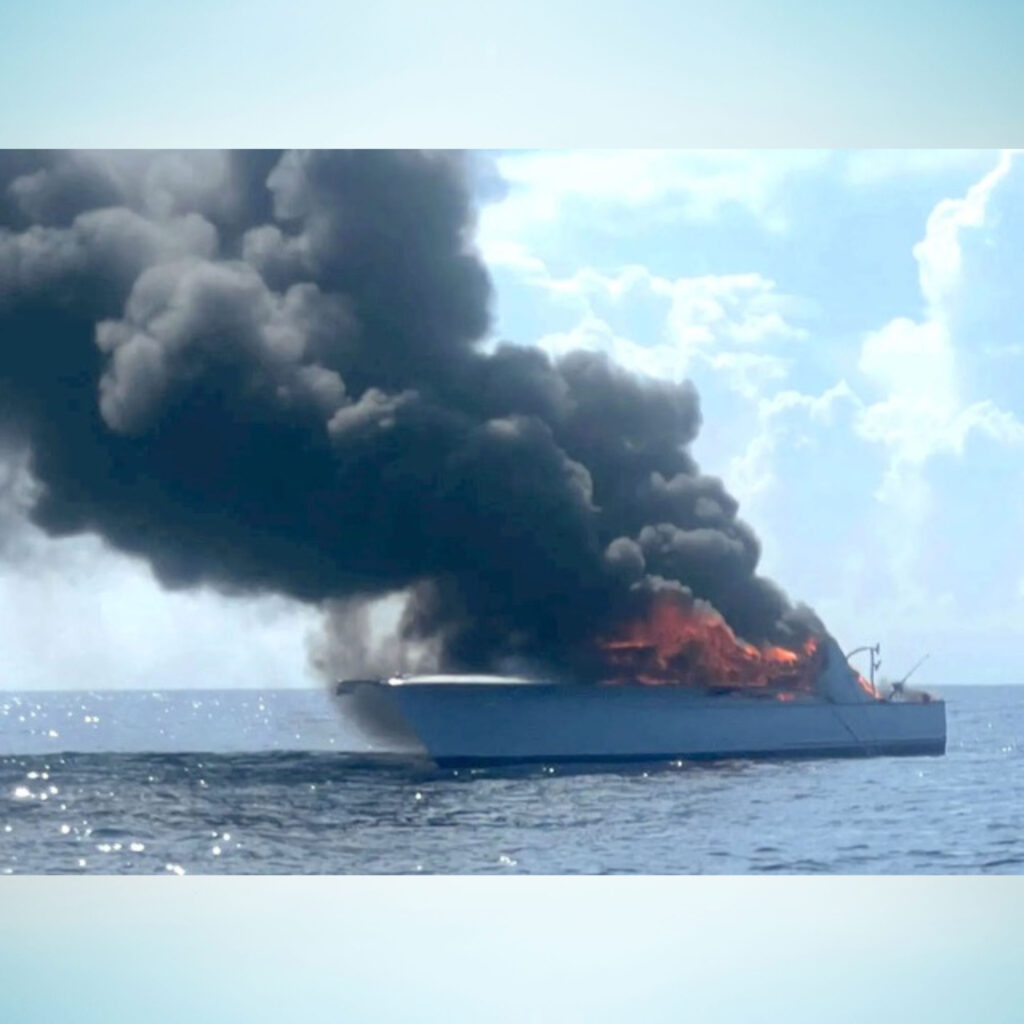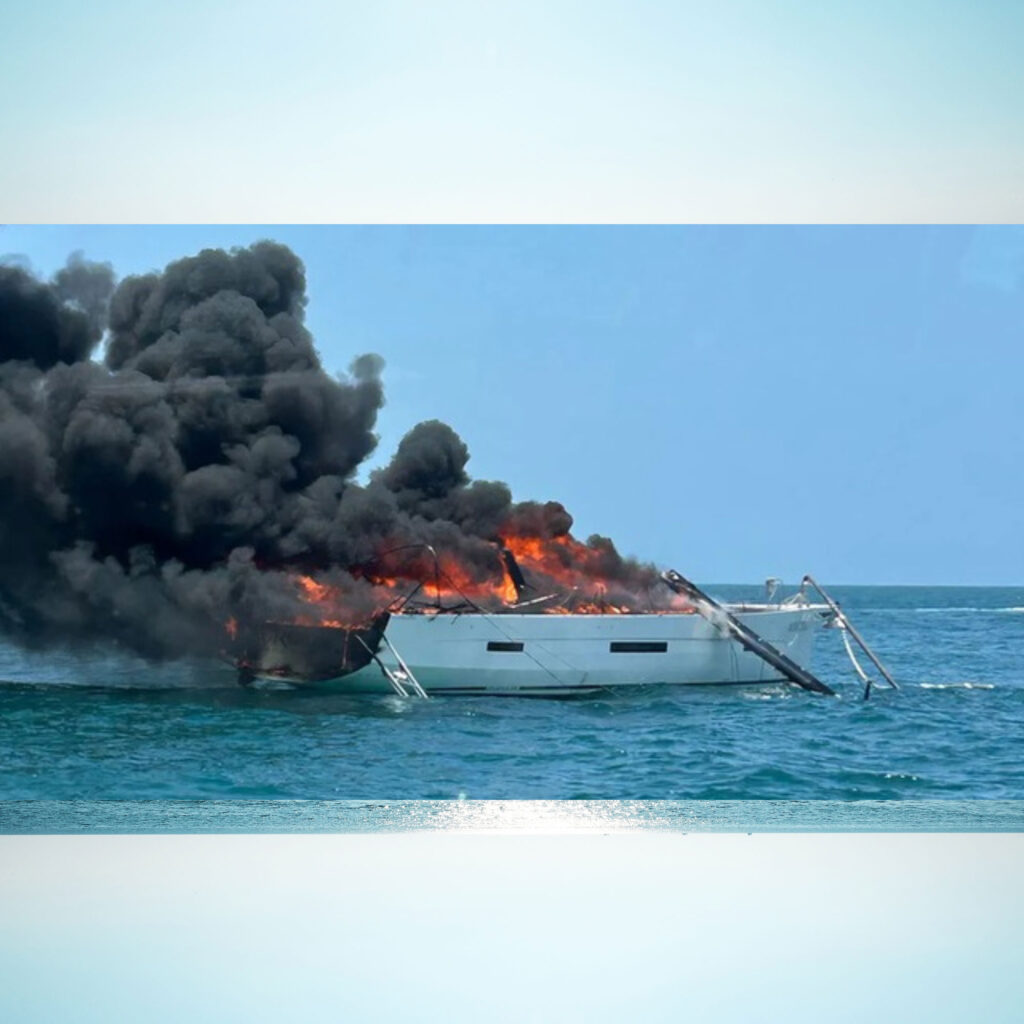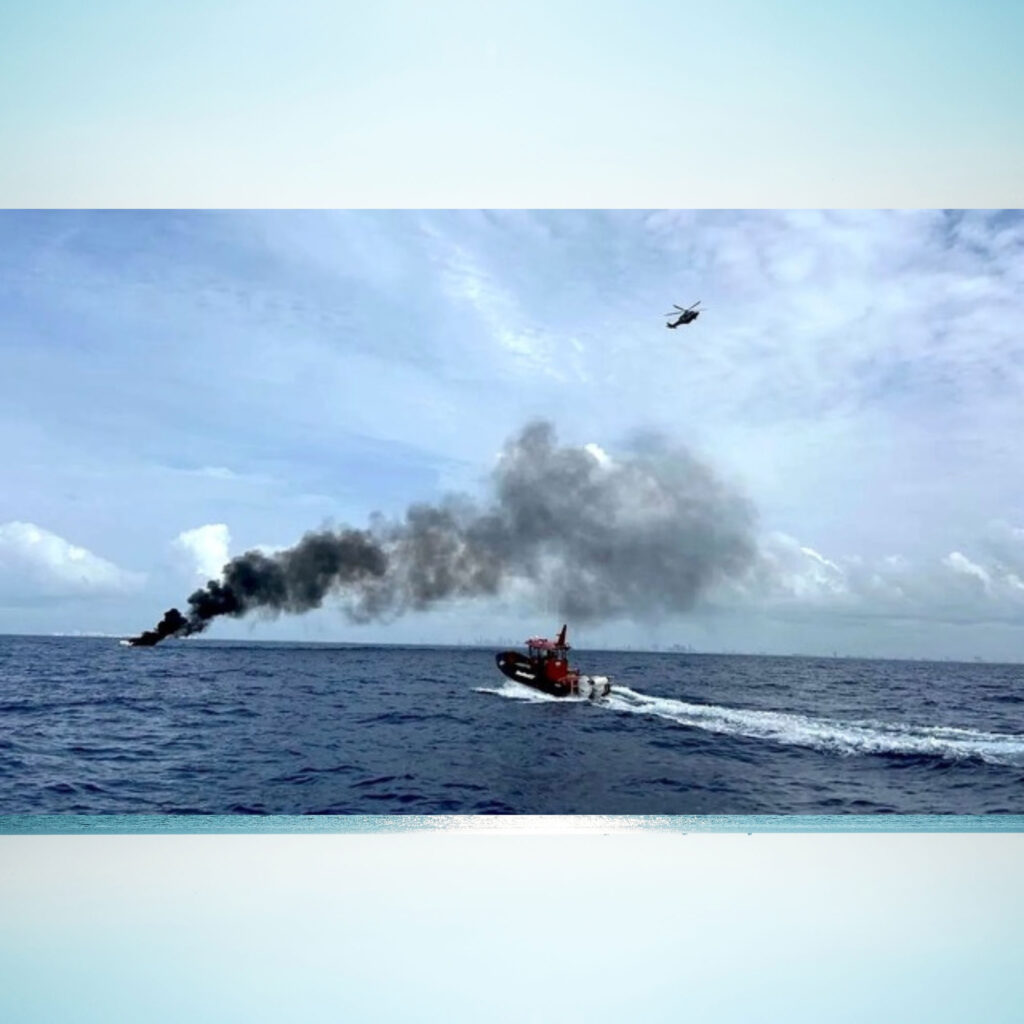SB Television
Fourteen Boaters Rescued From Offshore Blazes Thanks to Good Samaritans and Lifesaving Tech
 The 47-foot Buddy Davis sportfisher Raptor burst into flames on Friday the 13th of June.
Courtesy Coalter Paxton Peters / Facebook
The 47-foot Buddy Davis sportfisher Raptor burst into flames on Friday the 13th of June.
Courtesy Coalter Paxton Peters / Facebook
Fire at sea is among the most terrifying scenarios any boater can face. But in three recent boat fires—one off the Carolina coast, two more in Florida—14 boaters beat the odds thanks to quick action, good Samaritans, and the communications gear every boater should have aboard.
Five men aboard Raptor were forced to abandon ship after fire erupted aboard the 47-foot Buddy Davis sport-fisher on Friday, June 13. Smoke quickly overtook the galley and engine room, forcing the crew into the Atlantic Ocean about 50 miles offshore of Morehead City, North Carolina, with critical lifesaving tools in hand.
A registered emergency position-indicating radio beacon (EPIRB) activated as the vessel went up in flames, while a handheld VHF and Garmin inReach satellite communicator and handheld VHF radio allowed the crew to maintain contact with the US Coast Guard.
“EPIRBs take the search out of search and rescue.”
—Ian LivingstoneIt wasn’t long before help arrived—just eight minutes after the crew entered the water.
Nearby tournament anglers Cody Powell and Andrew Webb, aboard the vessel Cost Plus, saw the smoke and heard the distress call on Channel 16. Without hesitation, they altered course to render aid, according to details first reported on The Qualified Captain Instagram page. “All five onboard were rescued with no injuries thanks to quick thinking, the right gear, and some nearby Good Samaritans,” the popular boating Instagram channel reported. The captain and crew had an EPIRB, an extra handheld radio, and even used a Garmin inReach to stay in contact with the Coast Guard before and after abandoning ship.
“It was the best-case outcome for a worst-case scenario,” Powell later posted. “Good gear, calm heads, and a little luck.” The rescued crew plan a reunion on The Qualified Captain podcast, where they will share the full story of the dramatic rescue.
 The 61-foot sailing vessel Aurora burned to the waterline and sank off Cape Canaveral June 28.
Courtesy Canaveral Fire Rescue
The 61-foot sailing vessel Aurora burned to the waterline and sank off Cape Canaveral June 28.
Courtesy Canaveral Fire Rescue
Two weeks later, the 61-foot sailing vessel Aurora suffered a similar fate off Cape Canaveral, Florida. On June 28, the boat was just a mile offshore when it burst into flames, sending thick plumes of black smoke into the sky. Witnesses on nearby vessels and from Jetty Park Beach captured video of the fire. Some said they heard explosions as the blaze consumed the boat.
The four people aboard Aurora managed to send a Mayday over VHF Channel 16 before abandoning ship. That call was critical in guiding rescuers from Canaveral Fire Rescue and the Brevard County Sheriff’s Office to their position, though the pall of thick black smoke left little doubt as to their location.
“It was the best-case outcome for a worst-case scenario. Good gear, calm heads, and a little luck.”
—Rescuer Cody PowellA good Samaritan boat in the area took the crew aboard and brought them to safety with the assistance of local authorities. According to officials, the fire intensified when the vessel’s fuel tanks ignited. Aurora burned to the waterline and eventually sank.
The very next day, on June 29, back in the waters off Key Biscayne, a third vessel fire forced five people to abandon ship. According to the US Coast Guard, the boat’s owner used his registered EPIRB to call for help a few minutes before 10 a.m.
Coast Guard Station Miami Beach, the Miami Dade Sheriff’s Office and Miami Dade Fire all responded to the burning vessel 8 miles off Key Biscayne. Five boaters were rescued by a good Samaritan and brought to shore in good health.
 Rescuers en route to a boat fire off Key Biscayne, Fla., June 29. The owner used his registered EPIRB to get help and all five people aboard were swiftly rescued.
Courtesy USCG Station Miami Beach
Technology, Training, and Teamwork Save Lives
Rescuers en route to a boat fire off Key Biscayne, Fla., June 29. The owner used his registered EPIRB to get help and all five people aboard were swiftly rescued.
Courtesy USCG Station Miami Beach
Technology, Training, and Teamwork Save Lives
These three incidents underscore how quickly things can go wrong on the water and how critical it is to be prepared. Fire is not the most common marine emergency, but it’s certainly among the most terrifying. It’s been that way since the age of sail, but thankfully, modern marine technology stacks the deck in favor of survival.
When activated, EPIRBs and personal locator beacons (PLBs) broadcast distress signals and the device’s exact coordinates to rescue agencies. Thanks to a constellation of satellites, they work from anywhere on the globe. VHF radios with digital selective calling (DSC) can summon help when registered and properly connected to GPS.
While technology played a major role in all three rescues, the first tenant of the seafarer’s code—always render aid to those in need—was just as vital. In each case, fellow boaters responded without hesitation, saving 14 lives in as many days.
“This is a perfect example of why gear matters,” Ian Livingstone wrote in response to the Qualified Captain’s Instagram post about the Raptor fire. “EPIRBs take the search out of search and rescue.”
Whether you’re chasing gamefish offshore or cruising the coast, these rescues serve as a reminder that preparation saves lives. Make sure your safety equipment is on board, registered, and up-to-date. Practice emergency procedures with your crew, so if you ever need to abandon ship or come to the aid of fellow boaters, you’ll have the gear and skills to make it safely back to your loved ones. Because when the smoke rises, the right gear—and the right people—can make all the difference.
The post Fourteen Boaters Rescued From Offshore Blazes Thanks to Good Samaritans and Lifesaving Tech appeared first on Boating Mag.
- Home
- About Us
- Write For Us / Submit Content
- Advertising And Affiliates
- Feeds And Syndication
- Contact Us
- Login
- Privacy
All Rights Reserved. Copyright , Central Coast Communications, Inc.